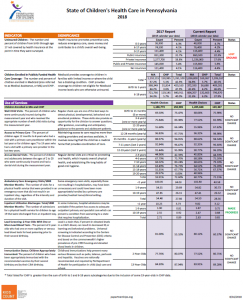PPC annually compiles “State of Children’s Health Care” data to track children’s health care in Pennsylvania as it relates to the Patient Protection and Affordable Care Act (ACA) and has monitored changes of those health indicators over a baseline year of 2010.
Information on children covered by publicly funded health care coverage is the focus of this report. This includes children covered by Medicaid, known as Medical Assistance (MA) in Pennsylvania, through managed care (Health Choices) as well as children covered by the Children’s Health Insurance Program (CHIP).
Even among children who are insured through programs like MA and CHIP, there are health care challenges that need to be overcome, as many of these children still are not receiving timely screenings, vaccinations and routine check-ups.
Highlights of the 2018 “State of Children’s Health Care” include the following:
Uninsured Children: The first step to better health is health insurance coverage. With nearly 96% of Pennsylvania children covered by health insurance, we have made progress over the past seven years on closing the uninsured gap. However, we saw a decrease in the number of insured kids over the last year signaling there is still more work to be done to meet the commonwealth’s longstanding goal of providing “universal coverage” for all documented children. Currently, more than 116,000 Pennsylvania children lack health insurance despite CHIP coverage being available to all uninsured children who are not eligible for MA.
Lead Screenings: There is no safe level of lead exposure in kids. With their developing brains and nervous systems, any exposure can put kids at risk for developmental and behavioral issues. This magnifies the importance of conducting lead screenings at an early age. The data shows there is much room for improvement needed in this area; however, it should be noted that combined progress of nearly a 9 percent increase has been made over the past seven years for MA and CHIP children.
Annual Dental Visits: Oral health means much more than healthy teeth; it reflects general health and well-being. Although the data shows only 6 out of 10 children going to regular dental visits, Pennsylvania is at least moving in the right direction according to the baseline comparison. While this past year shows no significant change in the rate, the data over the past seven years shows combined progress of a 13 percent increase for regular dental visits for MA and CHIP children.
Inpatient/Hospital Admissions: Reducing preventable inpatient or hospital admissions is a priority for many healthcare systems. Utilization of inpatient care or hospitalization of children on MA or CHIP has decreased by nearly 23 percent over the past seven years in Pennsylvania, marking this indicator as the most significant positive movement on the report.
Immunizations: Immunizations are vital in protecting children from many potentially serious or life-threatening diseases. An equally important step is ensuring the recommended vaccinations are being given at the appropriate times during infancy and childhood through adolescence. While no significant rate change is noted over the past year, progress of nearly a 7 percent increase was made since the baseline year.

